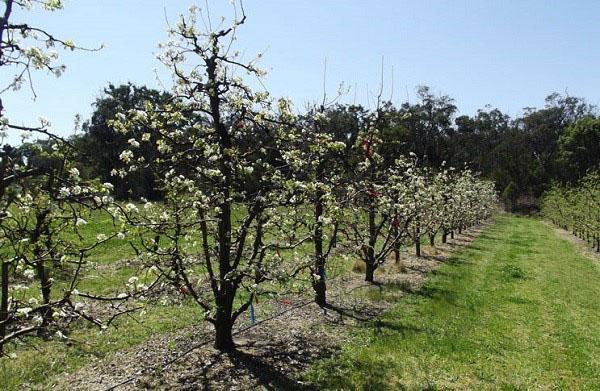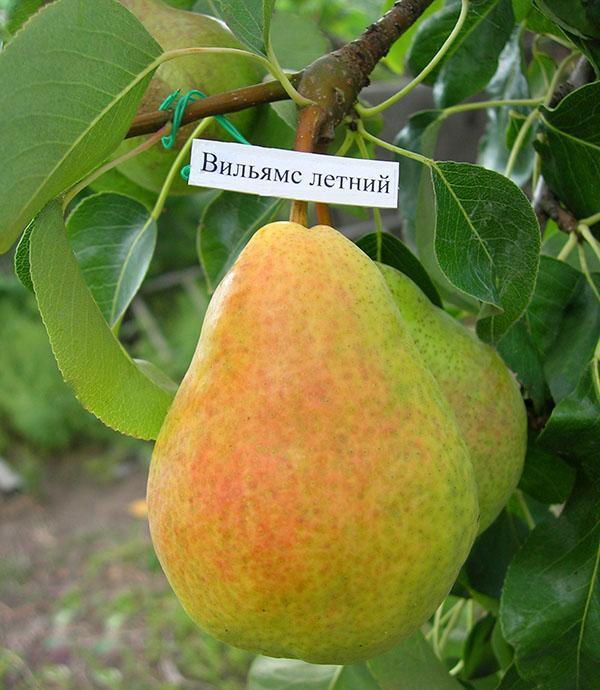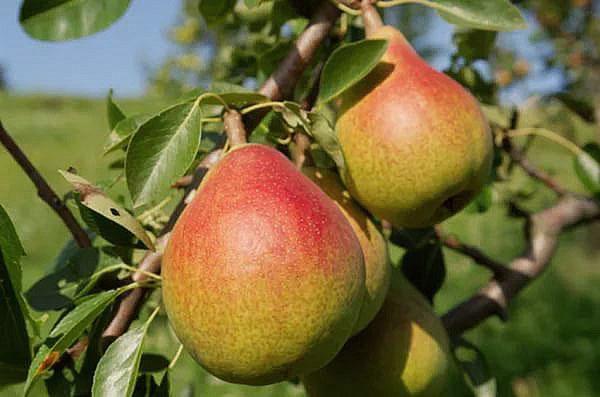Harvesting Pear Williams is a favorite among varieties
 Among the variety of varieties, it is worth highlighting the Williams pear, whose fragrant and juicy fruits will always find their lover. This variety was bred in England by the scientist Richard Williams on the basis of the common pear and is named after its creator. There are several subspecies of the variety, but the following are the most popular among gardeners:
Among the variety of varieties, it is worth highlighting the Williams pear, whose fragrant and juicy fruits will always find their lover. This variety was bred in England by the scientist Richard Williams on the basis of the common pear and is named after its creator. There are several subspecies of the variety, but the following are the most popular among gardeners:
- summer pear with the same name Williams Summer;
- late-ripening variety Williams Winter;
- pear with an unusual rich red color of Williams Red fruit.
Why this variety so attracted attention and what are the features of its varieties can be found in the brief characteristics of Williams pear with a description and photo, set out below.
Pear Williams Summer

Young seedlings grow quickly and soon form a not very tall tree (maximum 3 meters in height) with a dense crown in the form of a wide pyramid. The branches hang down for easy maintenance and harvesting. However, after 10 years of life, pear growth slows down as a result of regular, abundant and early harvest.
A feature in the characteristic of Williams pear is late flowering, while the inflorescences are tied before the formation of the deciduous mass. In addition, temperature drops have almost no negative effect on them.
 Fruiting occurs 6 years after planting. The fruits are tied in two or three pears in one ovary and begin to ripen at the end of August, while the skin remains green. If you harvest after the Williams pear acquires a yellow color, then its shelf life is significantly reduced. The average fruit weight is about 150 g, young trees for several years can give a larger yield (up to 200 g). The pulp is very juicy and sweet, with a subtle sourness and intoxicating aroma.
Fruiting occurs 6 years after planting. The fruits are tied in two or three pears in one ovary and begin to ripen at the end of August, while the skin remains green. If you harvest after the Williams pear acquires a yellow color, then its shelf life is significantly reduced. The average fruit weight is about 150 g, young trees for several years can give a larger yield (up to 200 g). The pulp is very juicy and sweet, with a subtle sourness and intoxicating aroma.
Pear Williams is self-fertile, for pollination it should be planted to it Forest Beauty, Favorite Klapp or Bere Ardanpon. A good result is given by grafting on a quince, in this case the pear begins to bear fruit from the third year of life.
The advantages of the Williams Summer pear are:
- excellent taste of fruits, which are not equal among summer varieties;
- high productivity;
- early maturity.
Among the shortcomings, it is worth noting the following:
- weak resistance to some diseases and pests (scab, aphid, honeydew);
- low winter hardiness, especially of young seedlings;
- susceptibility to drafts;
- short storage period (2 weeks).
Pear Williams Red
 This summer Williams pear variety is also called Rouge Delbara. Its characteristic features are the red color of the bark and leaves on young shoots, as well as the bark of adult branches, which are located on the sunny side. In addition, ripe fruits acquire a beautiful burgundy blush of a rich shade. It is convenient to look after an adult tree, since it is undersized, with a thin crown. Pear Williams Red has an average resistance to low temperatures and drought.
This summer Williams pear variety is also called Rouge Delbara. Its characteristic features are the red color of the bark and leaves on young shoots, as well as the bark of adult branches, which are located on the sunny side. In addition, ripe fruits acquire a beautiful burgundy blush of a rich shade. It is convenient to look after an adult tree, since it is undersized, with a thin crown. Pear Williams Red has an average resistance to low temperatures and drought.
 Fruiting occurs in the 5th year of life, pears ripen in the last days of August. The pulp is very tender and juicy, sweet and sour, with a delicate aroma of nutmeg. Medium-sized fruits are stored in the basement until the beginning of winter.
Fruiting occurs in the 5th year of life, pears ripen in the last days of August. The pulp is very tender and juicy, sweet and sour, with a delicate aroma of nutmeg. Medium-sized fruits are stored in the basement until the beginning of winter.
As pollinators for Red Williams, they use Klapp's Favorite, Bere Giffard, Bere Gardi.
Pear Williams Winter
 The second name of the variety is Curé. The tree is tall, with a dense crown, drooping during the ripening period. The branches grow at an acute angle from the trunk.
The second name of the variety is Curé. The tree is tall, with a dense crown, drooping during the ripening period. The branches grow at an acute angle from the trunk.
Fruiting for 5 years, pears are large (up to 250 g), slightly oblong, with a thick skin of dense structure. Sometimes a longitudinal brown stripe appears on them. The pulp of this Williams pear variety is sweet and sour, slightly dense (grainy) and moderately juicy. Produces a faint nutmeg aroma. The crop can be stored for up to 2 months.
The winter variety is also self-fertile; summer varieties Williams or Olivier de Ser are suitable as pollinators.
The main advantage of the variety is its high winter hardiness and drought resistance. A frozen seedling has the ability to regenerate. In favor of the Williams Winter pear is also the large size of the fruits and high yield.
 Among the disadvantages, one should take into account the fact that as a result of the cold summer, the fruits lose their taste. The amount of sugars in pears decreases and they become herbal. For this reason, the variety is practically not grown in regions with cold climates.
Among the disadvantages, one should take into account the fact that as a result of the cold summer, the fruits lose their taste. The amount of sugars in pears decreases and they become herbal. For this reason, the variety is practically not grown in regions with cold climates.
Despite some drawbacks, all Williams pear varieties are excellent choices for the gardener. Indeed, in terms of the taste of summer varieties, it practically has no equal. Its fruits are equally good for food or preservation. And the winter variety tolerates frost well and is capable of producing crops even after freezing. Given the characteristic features of the varieties and the climate of the growing region, you can get a delicious generous harvest every year.